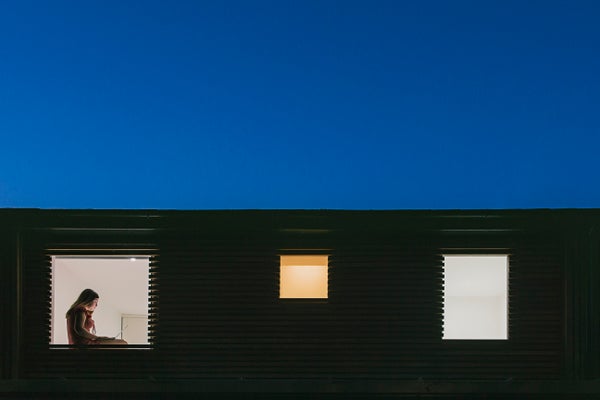After being diagnosed with COVID in November 2020, Andrea King Collier doubted the antibodies that she had developed in response to the illness would protect her from a second infection and was determined to be first in, or near the front of, the line for a vaccine. The Flint, Mich., resident registered at every vaccine distribution site she could find and never stopped looking for a way to receive shots early.By February 21 Collier had received her second dose of the Pfizer vaccine. But when the Centers for Disease Control and Prevention gave the green light for vaccinated people to resume prepandemic activities such as gathering indoors without masks on March 8, she did not experience the sense of freedom she had imagined. If anything, she became more fearful of infection. She has yet to eat in a restaurant or see anyone beyond her pandemic bubble. Formerly an avid traveler, Collier says she cannot imagine getting on an airplane again in the foreseeable future.
After a year in isolation, many people who have developed an intimate understanding of what it means to socially isolate are afraid to return to their former lives despite being fully vaccinated. There is even a name for their experience: the clinical sounding “cave syndrome.”
Emerging into the light after a year locked inside is proving to be a difficult transition for some people. Jacqueline Gollan, a professor of psychiatry and behavioral sciences at Northwestern University, says adjusting to the new normal, whatever it may be, is going to take time. “The pandemic-related changes created a lot of fear and anxiety because of the risk of illness and death, along with the repercussions in many areas of life,” she says. “Even though a person may be vaccinated, they still may find it difficult to let go of that fear because they're overestimating the risk and probability.”
On supporting science journalism
If you're enjoying this article, consider supporting our award-winning journalism by subscribing. By purchasing a subscription you are helping to ensure the future of impactful stories about the discoveries and ideas shaping our world today.
A recent study by the American Psychological Association reported that 49 percent of surveyed adults anticipated being uncomfortable about returning to in-person interactions when the pandemic ends. It found that 48 percent of those who have received a COVID vaccine said they felt the same way.
These long-term psychological effects were not unforeseen. In May 2020 researchers at the University of British Columbia published a study in the journal Anxiety that predicted that an estimated 10 percent of people in the midst of the pandemic will develop COVID stress syndrome after coping with severe psychological problems, such as post-traumatic stress disorder (PTSD) or mood or anxiety disorders.
Alan Teo, an associate professor of psychiatry at Oregon Health and Science University, attributes cave syndrome to three factors: habit, risk perception and social connections. “We had to learn the habit of wearing masks, physical distancing or social distancing, not inviting people over,” he says. “It is very hard to break a habit once you form it. There is this disconnect between the actual amount of risk and what people perceive as their risk.” He adds that there is a focus on “the risk of infection and death rather than the risk of dying from being lonely and disconnected.”
People are reluctant to resume their pre-COVID lives for different reasons. Some still have an extreme fear of the disease while others do not want to forfeit what they found to be the positive benefits they derived from the forced isolation and solitude.
University of California, Los Angeles, undergraduate student Genesis Gutierrez discovered he has actually preferred his pandemic lifestyle, especially the money he has saved by attending college virtually. “Postpandemic life means I would have to move to L.A. again and pay for a ridiculously expensive apartment to go to classes that I've been able to go to in my home,” he says.“I've been able to work from home, do stuff outside of academics and learn more about myself.”
Advances in technology, Teo says, have put people at more risk of developing hikikomori, an extreme version of social withdrawal lasting six months or longer that superficially resembles effects of agoraphobia, the fear of open or crowded places.“The $10,000 question is whether the prevalence of this type of extreme condition may be increasing as a result of COVID,” Teo says, “particularly in young people or adolescents, where the risk is greater because that stage is often when this extreme social withdrawal has been identified.”
So what can be done if someone is afraid to go out? Do people suffering from cave syndrome need professional treatment or just a bit more adjustment time? Northwestern’s Gollan says it all depends on the level of severity. If a person has symptoms of exhaustion, depression or anxiety, she advises measures that provide a sense of purpose in life: meditation, faith work, prayer, playing or listening to music.
Treatment for more extreme levels of anxiety require effective psychotherapy with a mental health professional who can offer cognitive therapy or other treatments that gradually expose a person to a stressful situation to resolve their fears. Medication may also be used at times.
Teo says there is a type of distorted thinking that maybe things will be better later. “Based on what we understand about immunity and the variantscoming onboard, quite the opposite is true,” he adds.
Read more about the coronavirus outbreak from Scientific Americanhere. And read coverage from our international network of magazines here.
